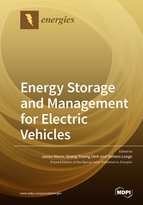Energy Storage and Management for Electric Vehicles
A special issue of Energies (ISSN 1996-1073). This special issue belongs to the section "D: Energy Storage and Application".
Deadline for manuscript submissions: closed (10 June 2019) | Viewed by 62038
Special Issue Editors
Interests: systems engineering; real-time control; systems modelling; design optimization; design of energy management control systems
Special Issues, Collections and Topics in MDPI journals
Interests: mechatronic systems design, modelling, and control; energy saving and management technologies; control theories and applications; battery management systems; renewable energy
Interests: autonomous systems computing, simulation, and modelling; electric and hybrid vehicles; instrumentation and sensors; mechatronics and advanced controls; on-road vehicle dynamics; systems engineering
Special Issue Information
Dear Colleagues,
Within the automotive and road transport sector, one of the main drivers for technological development and innovation is the need to reduce the vehicle’s fuel consumption and exhaust emissions, while concurrently exceeding consumer expectations for quality, driveability, refinement, and range. To meet this challenge, vehicle manufacturers, subsystem suppliers, and academic institutions are working together to design, integrate, and validate the different technologies that will underpin future powertrain technologies for the next generation of hybridised and fully electric vehicles (e.g. HEV, EV). Within the context of many electrified vehicle applications, the energy storage system will be comprise of many hundreds of individual cells, safety devices, control electronics, and a thermal management subsystem. The aim of this Special Issue of Energies is to explore research innovation within the systems engineering challenge that incorporates mathematical modelling, control engineering, thermal management, mechanical design, packaging, and safety engineering—both at an energy storage system level and within the context of the complete vehicle and end-use application. Specific areas of interest include, but are not limited too:
- New concepts in vehicle energy storage design, including the use of hybrid or mixed technology systems (e.g. battery and ultracapacitor) within both first-life and second-life applications.
- New concepts in energy management optimisation and energy storage system design within electrified vehicles with greater levels of autonomy and connectivity.
- The design, verification, and implementation of enhanced algorithms and models for battery control and monitoring, including new methods in state of charge estimation, state of health estimation, fast charge management, and active balancing.
- Novel methods of thermal management, including the creation of new models, the use of new materials, and their integration within the broader thermal management requirements of the vehicle.
- New techniques in battery system manufacture, including novel methods for cell interconnection, assembly, disassembly, and repurposing, both within the context of first-life and second-life applications.
- Improved integration of the electrified vehicle within the energy system network including opportunities for optimised charging and vehicle-to-grid operation.
- Telematics, big data mining, and machine learning for the performance analysis, diagnosis, and management of energy storage and integrated systems.
Dr. James Marco
Dr. Dinh Quang Truong
Dr. Stefano Longo
Guest Editors
Manuscript Submission Information
Manuscripts should be submitted online at www.mdpi.com by registering and logging in to this website. Once you are registered, click here to go to the submission form. Manuscripts can be submitted until the deadline. All submissions that pass pre-check are peer-reviewed. Accepted papers will be published continuously in the journal (as soon as accepted) and will be listed together on the special issue website. Research articles, review articles as well as short communications are invited. For planned papers, a title and short abstract (about 100 words) can be sent to the Editorial Office for announcement on this website.
Submitted manuscripts should not have been published previously, nor be under consideration for publication elsewhere (except conference proceedings papers). All manuscripts are thoroughly refereed through a single-blind peer-review process. A guide for authors and other relevant information for submission of manuscripts is available on the Instructions for Authors page. Energies is an international peer-reviewed open access semimonthly journal published by MDPI.
Please visit the Instructions for Authors page before submitting a manuscript. The Article Processing Charge (APC) for publication in this open access journal is 2600 CHF (Swiss Francs). Submitted papers should be well formatted and use good English. Authors may use MDPI's English editing service prior to publication or during author revisions.
Keywords
- energy management optmisation
- mechatronics and advanced controls
- systems modelling
- battery management systems
- drive-cycle creation
- thermal management
- energy storage ageing and degrdation
- system testing and verification
- vehicle-to-grid
- vehicle charging
- life-cycle assessment
- second-life energy storage applications







